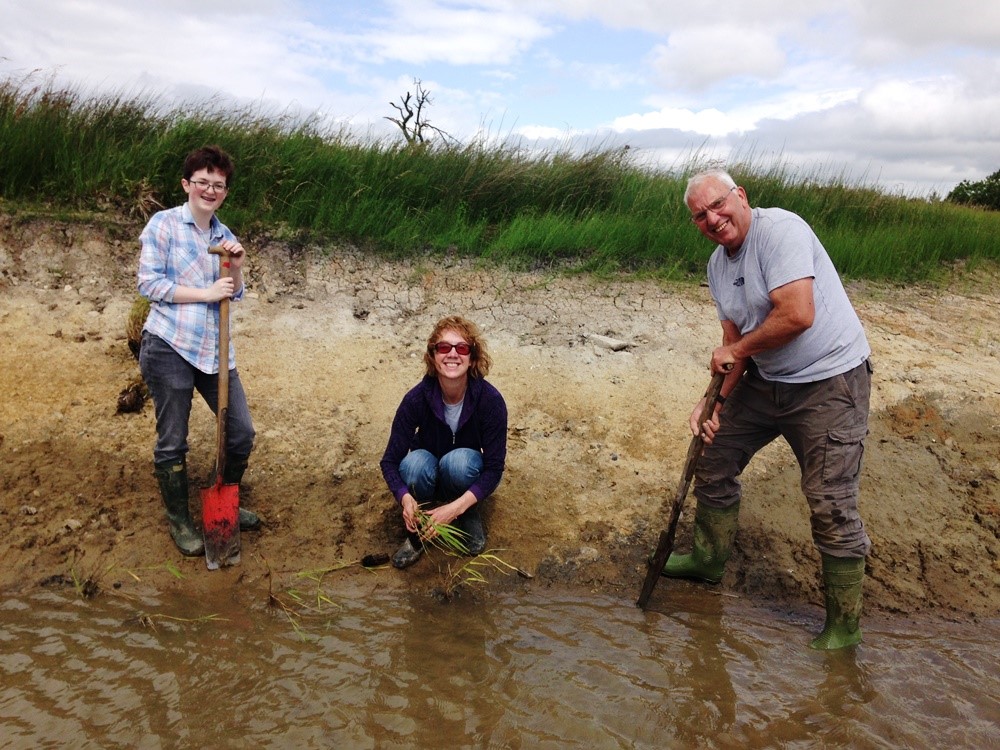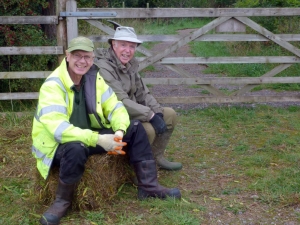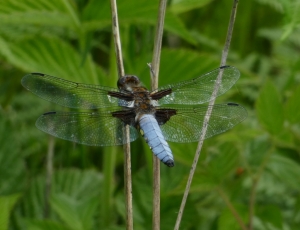Blog Archive (29) Posts Made in August 2016
Two Busy Days
Wednesday, August 31st 2016
Last night Elizabeth wrote a blog about some of the bird ringer’s antics up at Cape Wrath. This means we have two days of photographs for the blog to fit in today.
Yesterday was busy day for the Tuesday Volunteers. On the previous Thursday, the hopper seed had arrived so the workshop floor was largely taken up by 7 of the large one-tonne sacks of hopper seed. The first task of the day was to bag this all up into smaller manageable portions to be stored and used later in the year. This is no small task but the volunteers set to work enthusiastically.
By lunchtime the seed was all neatly bagged.
Afterwards it was transported and stacked neatly in our shed.
In the afternoon, the volunteers continued their work removing grass from one of the paths by the wetland. This is hard work, but we are nearly done.
Whilst out and about John found a Wall Brown butterfly which is quite unusual for Foxglove Covert; only being recorded on site every few years.

Today the volunteers spent some time identifying moths. Here are Glennis and Christine photographing some of the more unusual ones before releasing them.

Meanwhile, others did a wild flower recording session, coming back with a list of 77 species! This is a good effort considering how late it is in the season.

Also today we had the last of our Children’s Summer Holiday activities. Today’s theme was Seeds and involved some seed hunting around the reserve, learning about the different ways they disperse, and making seed bird feeders.
Visit to the Stormies
Tuesday, August 30th 2016
Over the Bank Holiday weekend some of the Foxglove ringing team headed back to Cape Wrath to ring Storm Petrels, Stormies, as they are affectionately called. These birds are not much bigger than a House Sparrow and spend most of their time at sea, only returning to land, in the dark, to breed in holes and burrows. They feed on plankton, small fish and crustaceans without actually landing on the sea surface.
This one is sporting its new ring.

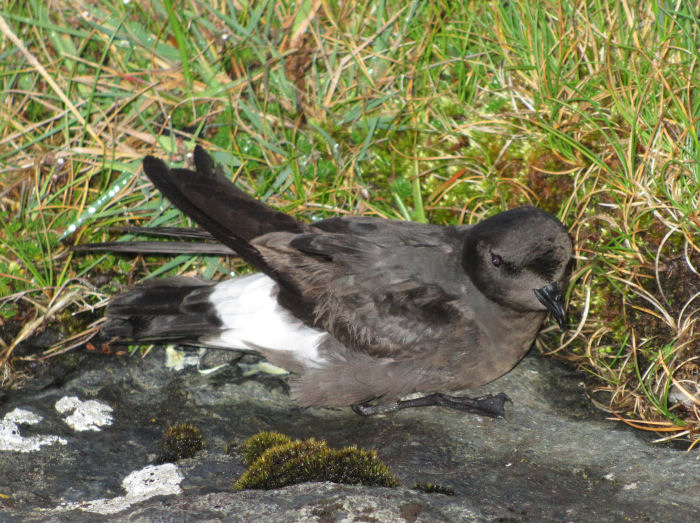
To reach the area for catching the birds is an interesting journey, sand dunes
.jpg)
and then grass, but this grass was not all it seemed and one of the landrovers got bogged down!
.jpg)
Adam to the rescue.
.jpg)
Someone would have a nice job removing the mud on the return home. (Think the rain they travelled through on the way home did the job!)
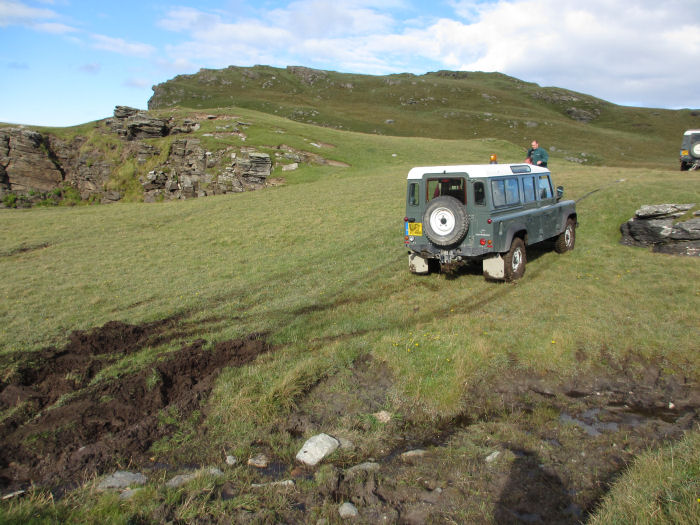
The landrovers have to be loaded with all the kit needed to catch and process the birds during the hours of darkness, so whilst still light everything was checked..

The 'ringing room' is the back of the landrovers and you can see everyone getting ready.

There was a little time to relax, before darkness fell and the Stormies arrived. Eleanor found a comfortable seat.
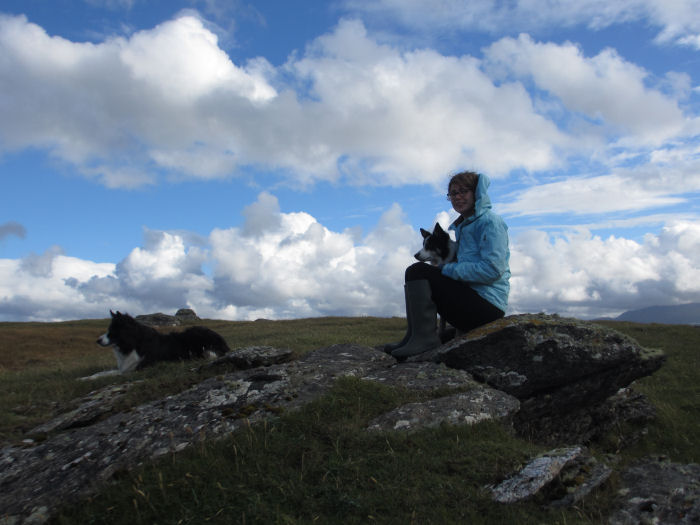
Initially the weather was good but it did not last and there were some heavy showers and the wind strength increased. The weather forecast for the last night was so bad, heavy rain and strong winds all night, that the team left early.
This was the scene as they left.
.jpg)
The team processed nearly 400 birds including 25 controls, one from Norway. Details of these birds will come through from the BTO.
The long journey back was through heavy rain but after a sleep the ringers were back at work on the Crater where another 70 Mipits were ringed and this beautiful Whitethroat.

There is never a dull moment! Winter bird ringing then the nest box season, followed by CES, with two visits to Cape Wrath. Visits to other sites and a Sand Martin colony towards the end of the summer. The last CES has to be carried out this week, 0530 start! As the evenings draw in so the time in front of the computer increases, inputting the data.
All of this hard work and commitment is very important in helping to gather data on bird species. The BTO is responsible for collating this data and advising land owners and government, who use this information to plan strategies to help protect our wildlife.
A huge thank you to the bird ringers at Foxglove and all the other volunteers who help and support them.
Sunshine
Monday, August 29th 2016
Today Foxglove was bathed in warm sunshine. Several families came in for a walk around and to enjoy the Bank Holiday Monday. Sunshine brings out the insects. Keith and June, our dragonfly experts came to visit, to see what they could find. They were not disappointed! Virtually every pond seemed to be full of tiny colourful damselflies, with large Dragonflies soaring around above them. They were able to record 4 different species of Damselfly and 4 species of Dragonfly. The most numerous were over 100 Emerald Damselflies and over 50 Common Darters. Here is an Emerald Damselfly.
One of our young photographers Rachael took some lovely pictures. Here are some of them. This is a female Common Hawker.
A Southern Hawker in flight (not an easy thing to capture on camera!).
Elsewhere she found some lovely butterflies, including this Brimstone, feeding on Devil’s Bit Scabious.
And this pretty Speckled Wood.
Offsite, the bird ringers were also out making the most of the day, ringing meadow pipits at the Crater.
The Wrong Sort of Rain!
Sunday, August 28th 2016
Heavy rain laden clouds covered Foxglove. The sound of rushing water could be heard. It is a while since the water was seen coming over the weir in more than one place.
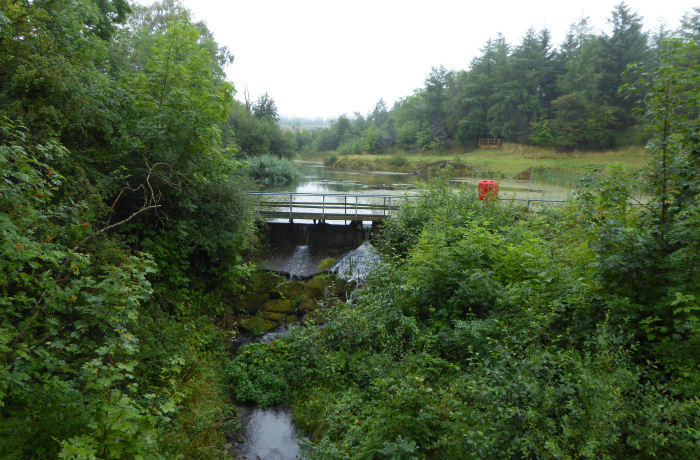
Walking through the reed bed it was clear that it had not liked the rain and most of it was laid flat, thankfully not over the main path. Feeding the Water Voles was interesting finding a way through without the water droplets going down your neck!

Standing on the pond dipping platform, it was amazing to see how flat the reeds in the pond were.

All this rain meant spider's webs and water droplets to photograph, but no it was the wrong sort of rain and very few water droplets were to be seen! The reeds did provide one photographic opportunity.

Down at the lake the wildfowl were unconcerned about all the extra water. Moorhens were walking about on the grass area and Mallards were sitting on the tree preening.

Later they were on the duck raft.

Counting the Mallard is interesting as they do not stay still but we did count 21. Little Grebes are not much better, as they dive and can come up a good distance away. But looking at the photograph above, there is a juvenile Little Grebe to the left corner of the duck raft and it looks different to this one, below, seen nearer the head of the lake. So possibly we have two pairs and two young? Binoculars needed and time to sit and do some counting.

Finds
Saturday, August 27th 2016
The subject for Eco Club was late summer, so we set off to see what we could find. Overnight the moth trap was set so we looked at the catch. This included Canary Shouldered Thorn but they would not stay still for a photograph but Centre-barred Sallow was more co-operative.

Autumnal Rustic is just beginning its flight season so looked very smart.
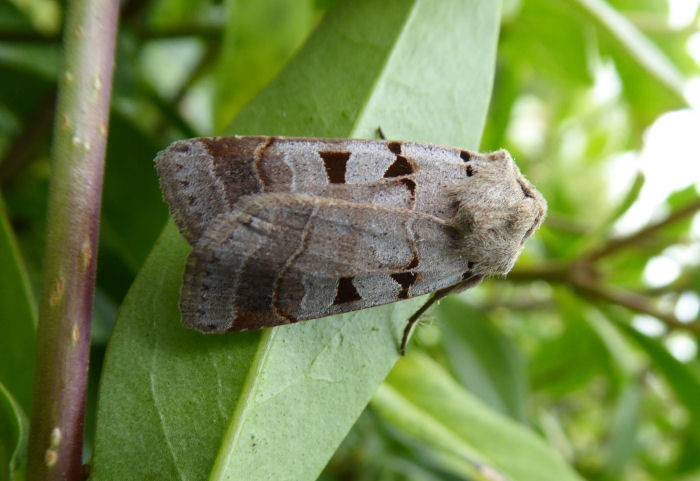
On our walk we shook some trees and there were some surprises. Spiders galore rained from a conifer tree, whilst this Common Darter fell from an Alder tree.

Speckled Wood, Brimstone and Red Admiral butterflies were all recorded. Feeding was the only thing on the mind of this Peacock Butterfly.
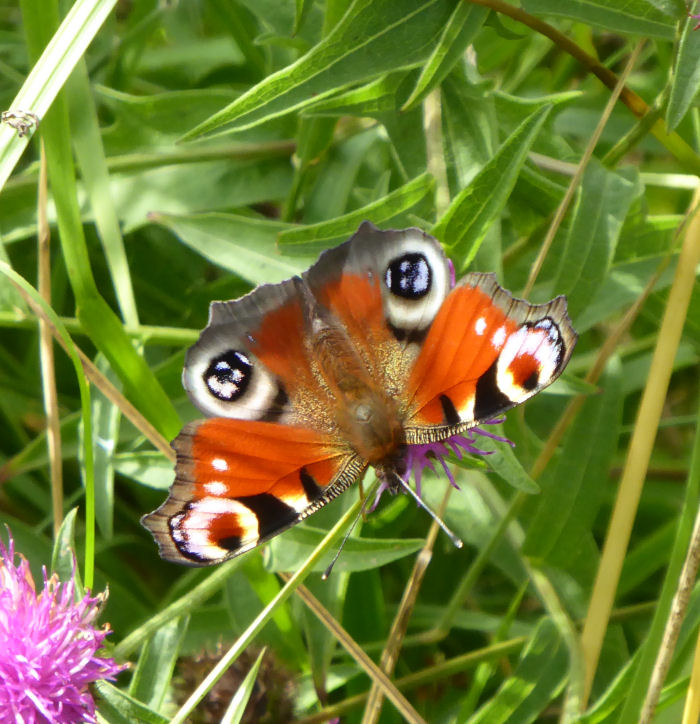
Groups of animals often have a collective name, but so far I have failed to find one for a group of Pond Skaters.
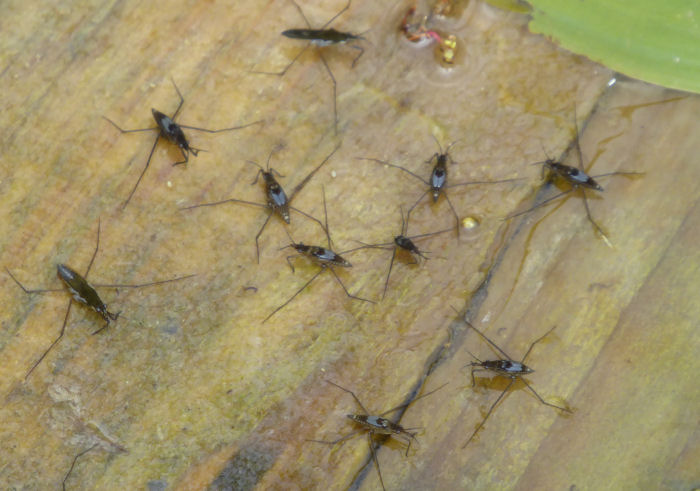
Flowers were not to be missed out and hidden away were some fresh Dog Daisies, looking unnibbled and very white.

As it was warmish and there was a bit of sun we decided to walk to the wetland to see if we could see the Common Lizards. A quick flick of the tail would be nice. As we rounded a corner there it was and there it stayed! We decided that it was out sunbathing to raise its temperature.

As we left the wetland sweep netting and catching many, many insects another Common Lizard was seen on the boardwalk edge.

The female lizard retains the eggs inside her and can often be seen sunbathing as she attempts to keep her temperature high, around 30 centigrade, to help with the development of the eggs. July sees the young born. They are about 3cm long. I have found no data as to the growth rates of these lizards, so estimating how old these two are is difficult, although judging by their length they are not this year's young. Males mature at two year old and females at three.
Many visitors enjoyed walking around in the sunshine and seeing darters, butterflies and Water Vole. Buzzards were calling overhead and a Chiffchaff was heard.
Volunteers yet again, showed their various skills by helping with Eco Club and carrying out some weekly jobs. Thank you very much.
Red and Gold
Friday, August 26th 2016
Whilst out on the reserve today I couldn’t help but think how nice it was looking. With autumn on its way, the grasses and trees are starting to lose their vibrant green colour, and instead the colours of autumn are starting to show themselves. The flower meadow is now golden.
We hope to get it cut in the next few days. After this, the grass from it will have to be raked up and removed. If we allow it to rot down, the nutrient content of the soil will increase and the grasses will then take over, reducing the number of wild flowers. Keeping it nutrient-poor is the key to keeping it looking so pretty.
In the Orchard, the apples are adding a splash of colour to the scene. These trees are only a few years old. Last year the orchard produced a grand total of one apple- this year it is great to see some of the trees laden with quite large fruit.
Some of these will be removed to feed the water voles later in the year; others will be left to fall to feed the mice and other small mammals.
The Rowan berries are also ripening well, and make a good show of colour at the back of the scrapes.
Damp
Thursday, August 25th 2016
Today it was rather wet. I don’t think at any point you could quite say it was raining properly, but it was certainly very heavy and persistent drizzle! The Thursday volunteers split into two groups. Half of them spent the day up on the wetland, doing some investigative work to try and work out why the water levels in some of the ponds were very low. Some drain clearing was then needed.
Meanwhile the other half of the group cleared the workshop in preparation for the arrival of 7 very large bags of hopper seed, then did some bracken bashing behind the wetland hide.
This is actually quite a fun task but is hard work. It removes the bracken fronds, and weakens the bracken itself, thereby hopefully reducing the amount of it next year.
Afterward we continued an ongoing task of tree popping in the Scrapes. Because a lot of these trees have been cut back countless times, they actually have a massive root system, and using the tree poppers often does not work. In these situations we have to resort to brute strength and digging them out with a spade.
The grand finale was the arrival of the hopper seed, right on cue at 3pm as expected. This arrived on a trailer, and it took a lot of strength to haul them all into the workshop, to keep them dry until they can be decanted into manageable sized portions.
Everything looked pretty and autumnal today, despite the gloomy weather. Some of the leaves are just starting to turn yellow, and lots of spider’s webs, covered in tiny water droplets could be found everywhere you looked.
Everyone worked hard today- your help was much appreciated.
Walk with a Camera
Wednesday, August 24th 2016
It was hot and most creatures were making the most of the heat and sun. There were toadlets and froglets walking around in the thick, low, shaded vegetation, making photography impossible. Butterflies on the other hand, were out and feeding on Saw-wort and Hemp Agrimony. Some Hemp Agrimony, being taller than me made some interesting butterfly photos, but patience was rewarded with this Peacock Butterfly.

Speckled Wood butterflies were flying in every glade where there was sunshine. This one looks a little battered.

Moth morning was interesting as the heat made the moths active, so again photographs were not easy to come by and lots of muttering as they flew off! This little Chinese Character - that is his name - behaved so well. It is some time since we last recorded this species. And yes it does look like a bird dropping, to fool predators.
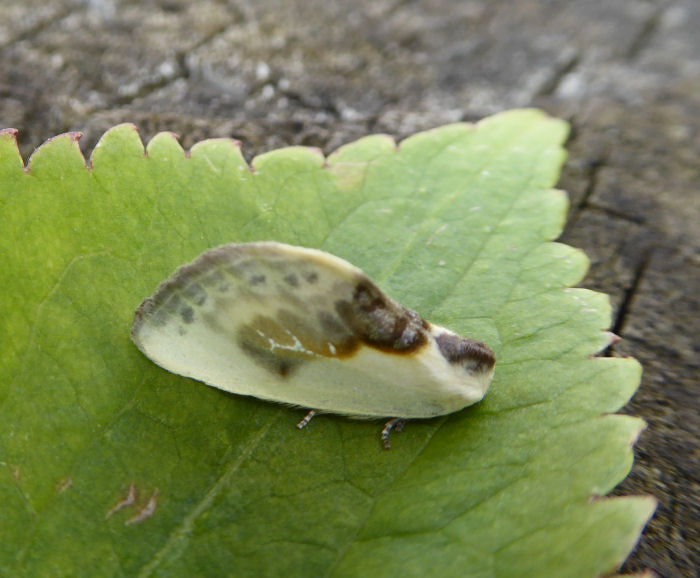
Another moth that co-operated was Pyrausta purpuralis. This moth flies by day and night preferring dry grasslands and chalky downlands as its habitat. The larvae feed on mint and Thyme. Foxglove has mint.

A disturbance on the lake, so camera at full zoom to see what was going on. Bath time for the Mallards. The Moorhens seemed totally unconcerned, one in the water one preening on the tree.

Walking to the wetland hide involves eyes moving from side to side in case there are newts, dragonflies or Common LIzards around. First lizard missed. Second one photographed, but don't get too excited, as you have to peer through the vegetation to see the splodge behind, which is the juvenile Common Lizard. Ah well keep trying!

Tip toes to the middle pond dipping platform and the thought that there was a brown mark above the apple was right. More tip toes and yes there it was feeding away. Photograph taken.

More in hope than anything else, walked very quietly along the boardwalk to be in a better position and amazingly the Water Vole kept eating, even though it was being buzzed by a Southern Hawker.
So a better photograph. Once it had had its fill, it quietly slid off the platform and into the water.

Camera had a great walk!
Rain at First, Fine Later
Tuesday, August 23rd 2016
It started off grey and wet at Foxglove this morning. It certainly didn’t feel like summer! Despite this the Foxglove volunteers still turned up in good numbers. First task of the day was a very dusty one, cleaning out not one, but two seed sheds, in preparation for the delivery of our hopper seed (a kind donation from an obliging farmer) sometime in the next couple of weeks.
Others set to work cutting back branches that were hanging down over the paths as a result of being weighed down by the rainwater.
Afterwards, the sun shone and we switched to an outside task clearing vegetation from the footpath by the wetland. We didn’t get it finished but we can clearly see which bits we have done.
Meanwhile, elsewhere on the reserve, U3a (the University of the Third Age) enjoyed a talk by Jennifer.
Afterwards she led them on a guided walk around the reserve. They all had a very enjoyable day out.
Thanks to everyone who helped out today.
After the Rain
Monday, August 22nd 2016
This morning was very wet indeed at Foxglove. We had plenty of indoor jobs to keep us busy though, so we made a good start on those without the temptation to go outside. Elizabeth had been planning a guided walk, and was busy contemplating what she should show people in the pouring rain.
At lunchtime however, the clouds parted and we were left with a sunny and blustery afternoon. The guided walk was enjoyed by all. After the rain the insects came out. Here are just a few that we found in the orchard.
A Common Darter Dragonfly
A Green Veined White Butterfly that obligingly came to Roger for a photograph
A slightly tattered Meadow Brown Butterfly
A couple of very different looking bees- Probably a type of Carder Bee (the ginger one) and a Garden Bumblebee.
Lovely?
Sunday, August 21st 2016
Without any shadow of a doubt, if the trees at Foxglove were not pollarded, coppiced or some cut down then in a very short time it would turn into an impenetrable forest! Sometimes it just seems that we can't win. Walking up the quad bike track looking at the dead hedge, with many plants growing around and through it, making it an ideal habitat for many animals, part of the 'dead' bit was growing!
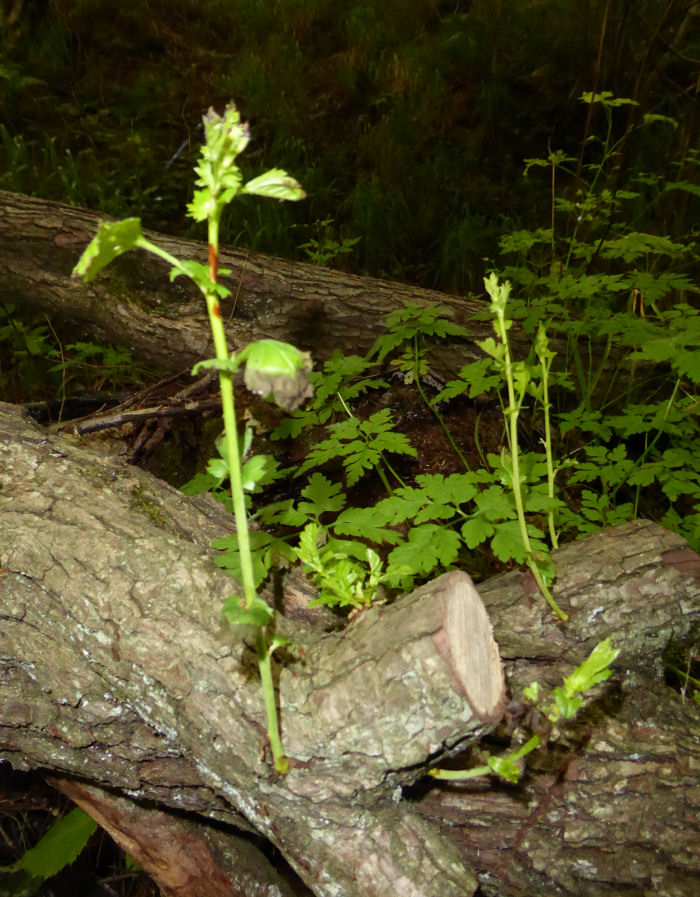
On closer inspection more shoots were were seen. The horizontal trunk they are growing from is a fallen tree that was included in the dead hedge and it looks like it was totally rotten at the base. Obviously there is enough sap flowing through the tree to encourage growth.
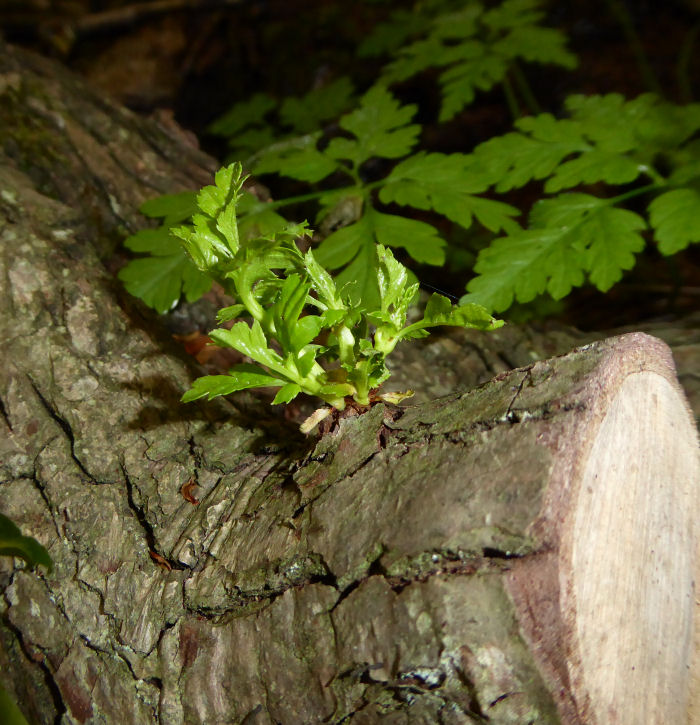
Alder is coppiced and this encourages the tree to grow new shoots. It also helps to keep the tree healthy. Many insects frequent the leaves, leaving them with a variety of holes. Believe it or not this tiny creature is an insect and has been found on Alder leaves when the children have been shaking a tree at the Outdoor Classroom. Initially we thought it was a greenfly trying to protect itself but it is much 'nicer' than that. It appears to be a lacewing larva that once having eaten its prey it adds the remains to its back as camouflage! Another will have to be found to look for the jaws!

A totally as yet unidentified creature is this wierd looking 'caterpillary thing'. It appears to have hairs along each side of its body.

Moving on to some much prettier organisms. Rosebay Willow Herb shows its pink spikes through the vegetation. Its other name, Fireweed, refers to that fact that it often grows on fire sites.

Many summer flowers have set seed and insects now rely on those just coming into flower. Hemp Agrimony can be seen in pink swathes through the Scrapes. In close up it does not look very attractive but it is to insects.

Devil's Bit Scabious is nodding its purple heads through the meadows and in the Scrapes. Another flower loved by insects.

Filming at Foxglove
Saturday, August 20th 2016
We now have permission to tell the tale of a Filming Day at Foxglove. Preparation for the day had taken place the week before and on the day itself everyone was there before 8. There were several sequences to film starting with felling of a diseased Ash tree that was becoming a safety hazard. The plan was to re-locate the tree into the middle of the lake where it would become an attractive preening and resting facility for the resident waterfowl directly in front of the disabled hide. The whole process was very much an unknown quantity and although the outcome was clear the method was quite a different story. Tony Robinson (Baldrick) is the star of the series and the story was centred around him. To begin with the canoe was carried down to the lake for use later in the day.

Sean, our tree surgeon, checked that everything was ready for the tree to be felled.

9am and we were all waiting, radios to the ready and cameras handy, for the filming crew and Tony Robinson to arrive. The radio crackled with the message that they were all at the guard room signing in and being filmed. An hour later they arrived at the lake. We realised that things would take some time, but everything had to be completed by 12.
First the volunteers had to 'pretend' to clear the area where the tree was to be felled. Several rehearsals took place and this piece of lakeside was absolutely immaculate, not a tiny branch to be seen!

After all that hard work some volunteers needed a rest!

Then it was onto the bridge for Tony (Crease) to be interviewed.

Finally, after ensuring everything was ready, the tree was expertly felled by Sean.

Despite naturally leaning the wrong way, it fell precisely where it should - with a large splash!
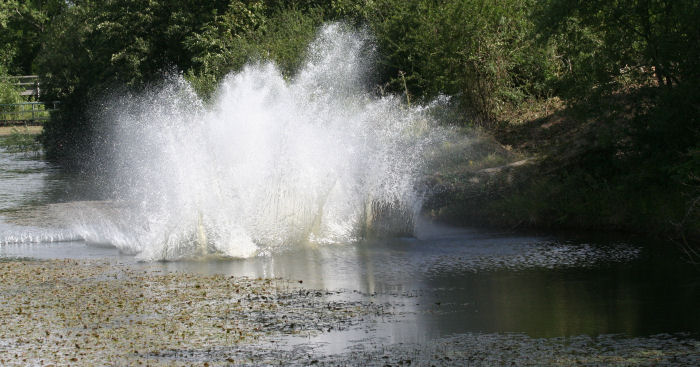
The rope had then to be moved so that the tree could be winched into the centre of the lake.

By this time midday had come and gone and the next deadline was 2pm. Tony Robinson, camera crew and volunteers returned to the Field Centre for lunch, tea and cakes. Moth trapping and bird ringing were filmed in turn.


2pm came and went, next deadline 4pm. Back at the lake it was time to move the tree from where it had fallen into the deep water.
Willie and the winch were filmed, after rehearsals of course. The tree did not move - yet.

Finally, all was ready, and the tree was slowly winched out into the lake. It was heavy, weighing several tonnes.

Roger put on waders and entered the water to ensure that everything was in the correct location for the last few precise movements of the tree. By 6pm it was in exactly the spot we wanted.

Sophie, in the lake hide, was radioed to confirm the tree was exactly where it was planned to be. It was!

Having had an eventful and successful day Tony Robinson and the camera crew eventually left at 6.30pm followed by staff and volunteers shortly after. All the planning, with expert input from Sean and Willie, and the hard work from staff and volunteers, meant the day went without a single problem and the outcome is fantastic.
A huge thanks is due to everyone involved. The day could not have gone as well without your support and hard work - and a measure of good fortune!.
The following day stakes were placed around the tree by Roger and Stacey to keep it in place during windy conditions. The water in the photograph is actually 2m deep and braying in posts whilst balancing on a submerged branch can be tricky!

Already the tree is well used and the Mallards and Moorhens have been seen sitting on it regularly..
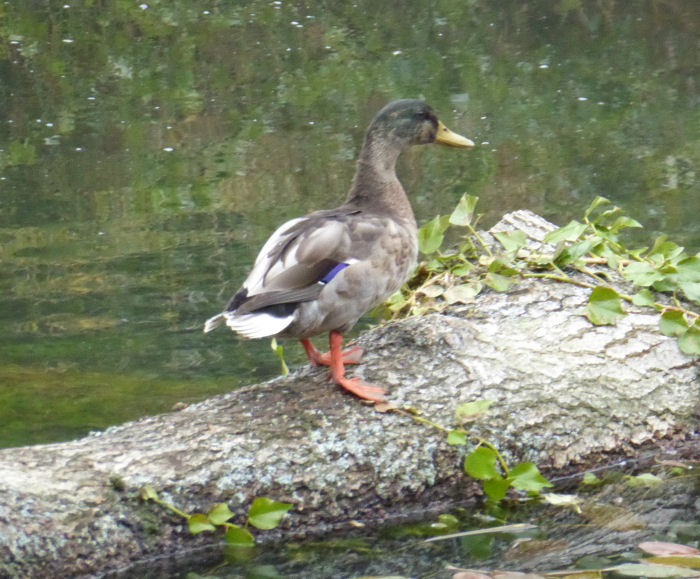
The filming was for a programme called 'Coast to Coast' and it should be on Channel 5 TV towards the end of October or early November. We will let you know when we have confirmation of the date.
From Sun to Rain
Friday, August 19th 2016
Yesterday was pretty much dominated by ringing of the birds - see the previous Blog entry. However behind the scenes the volunteers continued with the important tasks of keeping the reserve flowing, in more ways than one! As always the varied jobs are allocated and the team gets on without complaint, and plenty of banter.
The lack of water at the Bullet Catcher Pond had the team fixing a dam and rodding the inflow pipe.
Mean-while the steps on the Lake Hide had to be repaired, John as always getting down to the job.
John also returned today to finish a few jobs he started yesterday. We now have a new shelf in the tool shed, as well as cleared paths from all the strimming debris.
This picture below of the Speckled Wood Butterfly was taken from below before the rain began to fall this afternoon.
Thank you to all the volunteers for their continued help.
Almost Bright Eyed and Bushy Tailed!
Thursday, August 18th 2016
Some of the bird ringers have had several early starts recently. They were at another site over the weekend and at the Crater this week, as the Mipit season has just started. CES 11 had to be carried out today as the forecast for the weekend is so wet and windy.
There were four Kingfishers caught over the weekend and the photos taken show what beautiful birds they are. No excuse for showing several photos.

It can be difficult to ensure a good photograph that does the bird justice, as they can decide to have a good look around by moving their heads180 degrees. This is rather disconcerting when watching them through the camera. So to get two together, watching each other is an excellent result. Thank you Leanne.

Most often the only thing you see of a Kingfisher is a flash of brilliant blue and in this photo you can see why that is so.

Ringing Meadow Pipits, Mipits, started in late August 2011, since then we have ringed over 7300. The weather at the Crater is critical and although calm at Foxglove, the wind may be blowing at the Crater so ringing is unable to take place. Being so 'high up' you can see any inclement weather that is coming your way! We are catching the birds as they stop on their migration route to feed, so the season is limited to about eight weeks.

The majority of the birds caught are Mipits but the catch can include Willow Warblers, Goldfinches and Swallows. This juvenile Swallow was caught yesterday.

CES 11 started dull but the sun came out and it was very warm. The nets were raised in net rides that were in pristine condition thanks to the reserve managers and volunteers. Huge thanks to them all. Adult birds are still hiding away moulting so the majority of birds were juveniles. A Great Tit made an appearance today that had fledged in 2009, making it seven years old. Each net is numbered. One Great Spotted Woodpecker was caught in the garden net and then flew down to the lake and was caught again. Radio contact ensured that it was released immediately. Other birds processed included Willow Warblers and Chiffchaffs, Song Thrushes, Bullfinches, Siskins, a Reed Bunting and a Nuthatch.
Thank you to everyone who helped today.
Ponds and Arty Frogs
Wednesday, August 17th 2016
The day started at 6am for the team here, we were ringing meadow pipits on the training area before returning to the reserve for 9 to prepare for the event of the morning ‘Ponds’.
There were plenty of froglets and toadlets about, requiring careful walking. The pic below is one of the diving beetles we were lucky to pond dip
.
Here are a few snaps of the group having pond dipped, then into the classroom for some creative time…. this case making a frog eyes out of egg boxes.
and frogs!
Please come to our next event on Wednesday the 24th August, on 'Tracks and Signs'. Visit the Web site for booking.
Heath and Heat
Tuesday, August 16th 2016
Today was a sunny day at Foxglove, good for getting a variety of outdoor tasks done. The main job was working out on the Heath. We spend a lot of time trying to keep our Heath looking like one- small willow and birch trees are very persistent growing, and if left to their own devices the whole area would soon become a woodland, overshadowing all of the heather and heathland plants.
It was a hot day, where even if you stood still you sweated, but the volunteers worked hard. By the end of the day a good patch had been cleared.
Some of the other volunteers took advantage of the nice dry weather and made a start painting the portacabin. The two twins, Conaire and Martin worked hard to finish the bulk of the painting…. thank you boys!
Whilst out on the heath we found this very nice Brimstone butterfly.
Thanks very much to everyone who helped out today- we know it was a hot day for working!
A Day of Surprises
Sunday, August 14th 2016
A Lesser Swallow Prominent moth decided to lay her eggs in a container. So the container was placed in the 'caterpillar nursery' to see if they would hatch. This morning there were tiny caterpillars crawling around. Silver Birch, one of their their food plants, and we have plenty of it, was collected for them. Immediately they began to feed.
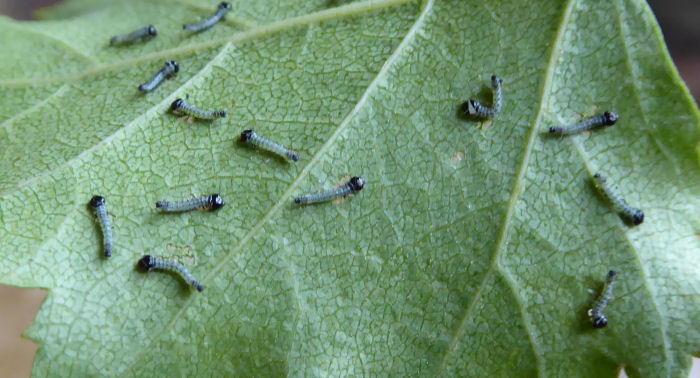
By lunch time you could see the holes in the leaves where the caterpillars were feasting. Not a brilliant photo of the caterpillars but you can see the holes! We presume that as they are so small they are unable to chew the edges of the leaves and so rasp the cells off. It will be interesting to see if they do actually eat the edges as they increase in size.

Daydreaming along the boardwalk to the middle pond dipping platform, I eventually noticed a brown mark next to the apple so set myself to take a few photos of the Water Vole.

The next photo shows that the apple was on the move! We decided, very unscientifically, that 'she' had taken the apple back to her nest to feed her young. A bit more thought and a further unscientific conclusion was that she took it back for herself as it was tiring to keep coming to the platform when it could be much closer to home. There was no sign of the apple when the pond was checked later.

Our (when I think about it all the plants and animals on Foxglove are 'ours') Dabchick chick has grown. Whilst watching it sitting on the water it seemed to know where the adult would appear after a dive.
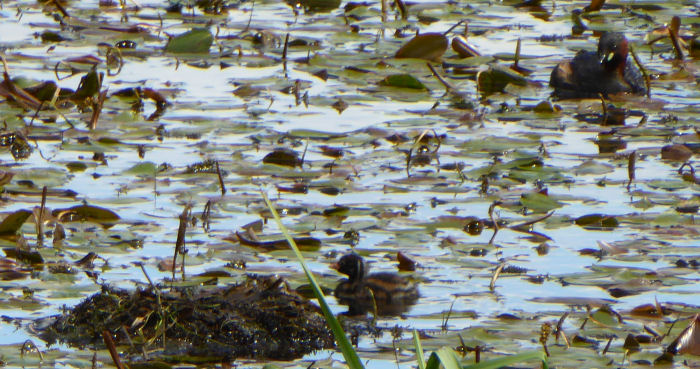
'Our' Mallard with nine young has done really well to raise all of them and they are now well grown. One of them rested on the tree, next to a juvenile Moorhen.
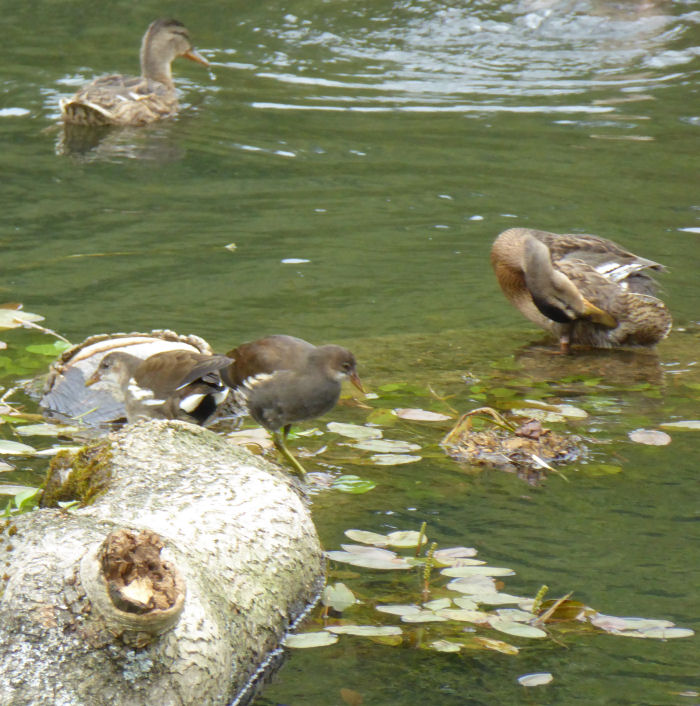
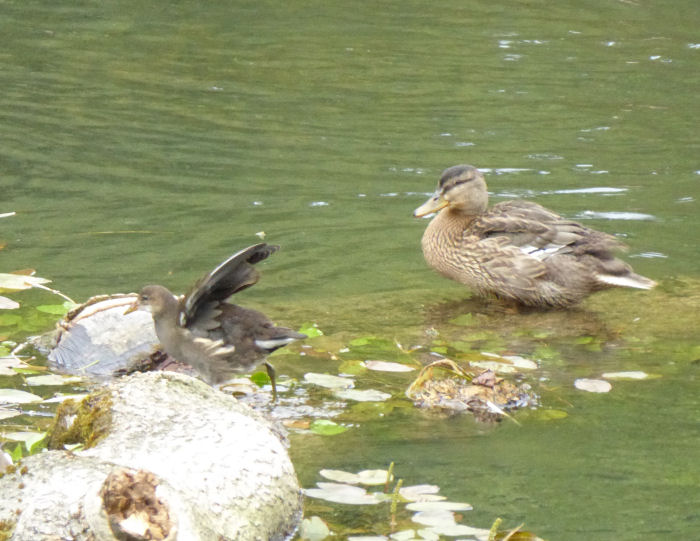
Chldren love to see the frog hoppers hop. Unfortunately taking a photograph of them is difficult because they hop! These two, possibly male and female were intent on each other so allowing photographs to be taken. They are Green Leaf-hopppers, Cicadella viridis.
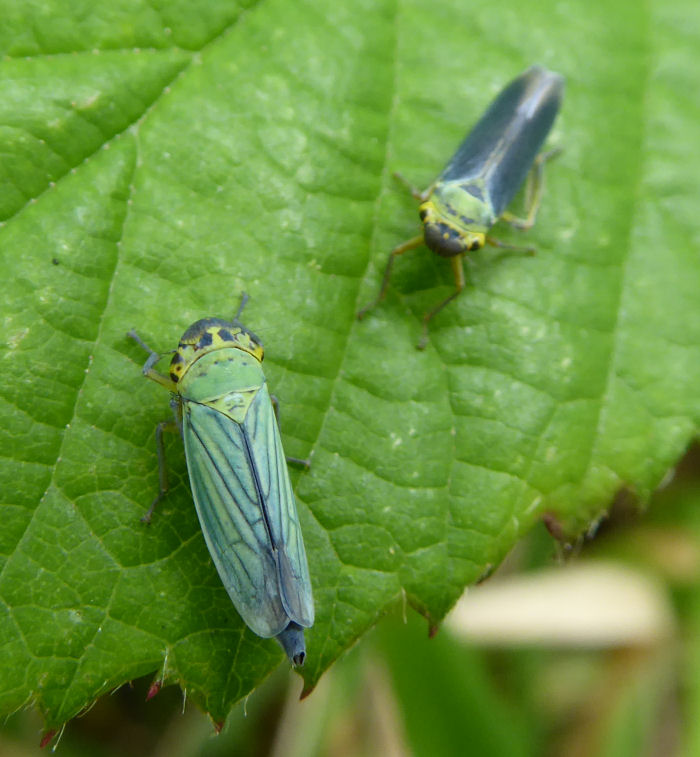
Grass of Parnassus has started to bloom. The flower has a complex structure. It attracts insects with its slightly honey scent, honey guides on the petals and a sweet sugary substance on its false stamens.

Larvae
Saturday, August 13th 2016
Walking across the bridge a rescue had to be carried out. A yellow caterpillar with black thread like appendages was just about to fall through one of the spaces. Unfortunately it did not hang onto a leaf when transferred from a white hanky so the only photo we have is on a white background. This is an Alder Moth caterpillar. Records show that it is not common on the reserve, the adult only being recorded six times and the caterpillar twice.

There are other larvae to be seen. Under the Alder leaves are Green Leaf Beetle larvae. These ones have just hatched out from their eggs.

On the underside of a Sycamore leaf was a lone 22 Spot Ladybird larva.

A Mixture
Friday, August 12th 2016
Today is a bit of a mixed bunch of photograph as there seems to have been a lot of different things going on. This morning we held a Food Web Fun children’s activity. The children played a game, making themselves into a human food web, involving a big tangle of bits of wool. Afterwards they did a food web treasure hunt around the reserve, looking at who eats who.
They finished the activity morning by creating their own food chain hanging models and looking at some of the creatures in the classroom.
Whilst out and about we found several tiny toads.
We also found some golden raspberries. These look quite different to the usual red ones, but I am told are equally as tasty!
The moorhens on the lake have another brood of chicks. They were moving quite fast, hence the slightly fuzzy photographs!
Our two cows Liquorice and Fern are still happily munching their way through some of the vegetation on the wetlands.
Being Dexters, they are very small, and surprisingly difficult to spot. The vegetation still seems to be higher than they are in many places!
Wetlands and Wheelbarrows
Thursday, August 11th 2016
The wind did not help at all with the jobs outside today, at least it was dry, but as always the Thursday volunteers just got on without complaint.
The entire team worked together dealing with the Wetland water levels and discovering an inflow problem, a blocked filter at the source , but also water was going around the sluice confusing the issue. Mike and John spent the afternoon dealing with this and thankfully solved the issue.
The water for the Wetland and the Scrapes ( pond dipping platform ), is distributed from the above area, which is a natural water spring, and as mentioned before the lack of nitrates and phosphates and the purity of this source is certainly beneficial to our site.
Peter and Tony having cleared various drainage pipes then fixed a few wheelbarrows in the workshop, new tyres/innertubes…. it seems strange to be thinking of preparations for our Winter Worky Days, but as I look around the reserve the Orchids have gone over and the nettles are beginning to go yellow in places.
Whilst strimming this afternoon we get to check over the reserve and see what and where the next weeks jobs are priority. It looks like the Heath will be a major job, clearing more unwanted shrubs like Willow, Birch and Gorse from taking over.
The Ling heather on the heath is in full bloom, and the various flying bugs were making the most of them. This Honey Bee above, probably foraging from our Field Centre hive, was working along-side various Bumblebees and Hoverflies.
Mike and Tony still smiling after a hard days work, thank you also to Peter, John and Jackie for their much needed assistance.
Owl Pellets, Moths, Paths and Rushes
Wednesday, August 10th 2016
We have had a busy day at Foxglove today. The day started like a usual Wednesday with the moth identification from the moth trap. Here is one of the nicer specimens from today- a Chevron Moth.
Afterwards Glennis hosted our Owl Pellets for Families event. This was well attended with a big group of visitors. This photograph, taken by one of the participants, Gillian Lunn, shows some of the action that was taking place.
.jpg)
The families learnt about owls and then had a chance to dissect their own pellets to find out what they had been eating. Thanks very much to Glennis for running the event.
Elsewhere on the reserve we have been outside doing a bit of practical work. The reeds and vegetation in front of the Lake Hide were given a trim as they were obscuring the view of the lake.
Afterwards one of the paths was repaired and more gravel was spread to level it out. This was then flattened using the whacker plate.
Whilst out and about we found these pretty Harebells and noticed how big the Spindle tree seeds are getting.
Inside the Field Centre, Ruth and Elizabeth spent some time setting up a new display of pictures. Thanks to everyone who helped out today, in a variety of different way.
Grebes and Trees.
Tuesday, August 9th 2016
Yesterday was a very busy day at Foxglove with some tree felling, some winching, some boating, some bird ringing and some moth trapping. The reason for this was the filming of a TV programme, so in addition to all of these activities, there was also a lot of standing around, and waiting (known in filming terms as “Hanging” apparently) and a lot of repeating things several times for the cameras. We are not allowed to release any more details of this for another couple of days but all will be revealed shortly when we are able to let you know. There will be plenty of pictures to follow. We are very grateful to everyone who made Monday such a success, both on the day itself and in the week of preparation running up to the event.
The Little Grebe family that have been living on the lake finally hatched. The “little” Little Grebe can now often be seen riding around on its parents back as they move around the lake. You can see its head sticking out from its parents feathers in this picture.
Meanwhile, the Tuesday volunteers spent the day clearing logs and brash from Monday’s antics, then moved on to tree popping through the scrapes.
This is hard work, especially when the sun is shining, but we made some good progress. There is still quite a way to go with this, but at least we can see the results of what we have been doing by the large piles of pulled vegetation.
Thanks to everyone who helped out today.
Rambling through the Species
Sunday, August 7th 2016
We have walked past the ponds and said casually 'Pond Skaters'. Then we walked past the ponds and said very knowledgeably 'Instar Pond Skaters'. Photographs were taken and then the images blown up on the computer screen and a little bit of research was required. Some of our Pond Skaters are not Pond Skaters but Water Crickets.
At the minute Water Crickets seem to be living quite happily in the becks that run across the moor. The ones below are to be found in the stream leaving the wetland. There is unlikley to be many insects surviving a fall onto the surface of the water! You can see that these insects are coloured orange along their abdomens.
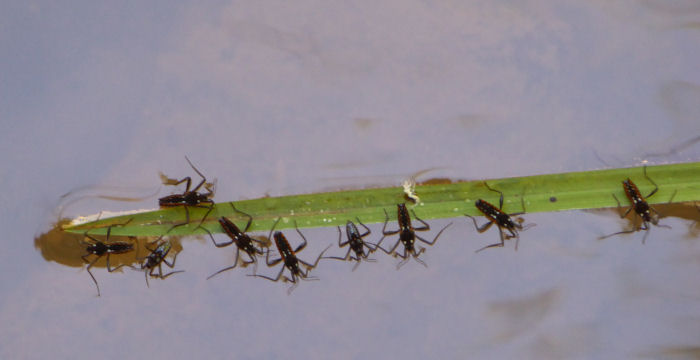
In the Scrapes we appear to have Pond Skaters.

Entering the data into IPMR (the ringing data programme) is fascinating. As the seasons progress there are changes. During May, fewer females appear as they are sitting on the nest. Now, in early August, not many adults appear and those that do, are looking a little worse for wear as they moult. Our summer migrants have different moult times to our residents, as they have to head south on migration. The bird ringers have to learn all of this as part of their training.
During CES 10 many juvenile birds were processed in the final total of 208. Twenty one different species were recorded, including Reed Bunting Garden Warbler, Willow Warbler and Chiffchaff. Numbers of Siskin, Chaffinch and Bullfinch are increasing.
One of the Sand Martins ringed nearly two weeks ago has been caught again. We are waiting to find out details.
Some insects we know, almost personally, like the Kidney Spot Ladybirds on Kidney Spot Corner. They have been a little elusive recently but some larvae have been seen walking up and down the Ash tree. Slowly they are spreading their range and being found on other trees and on bridge hand rails!
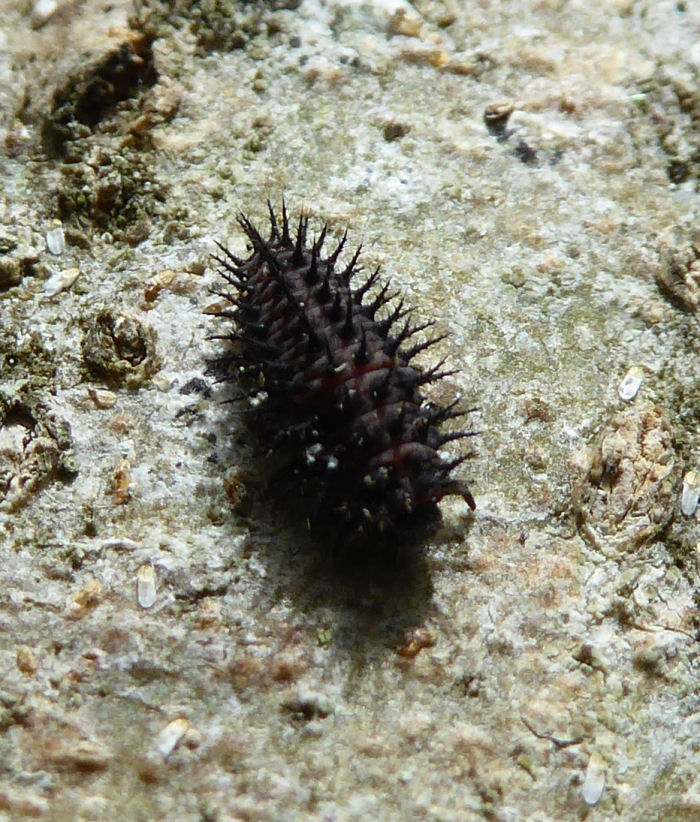
Other insect's names require more reasearch, like this one sitting on an Angelica flower head. A slight problem both for it and for me was that the wind was blowing it around, especially its very long antennae!
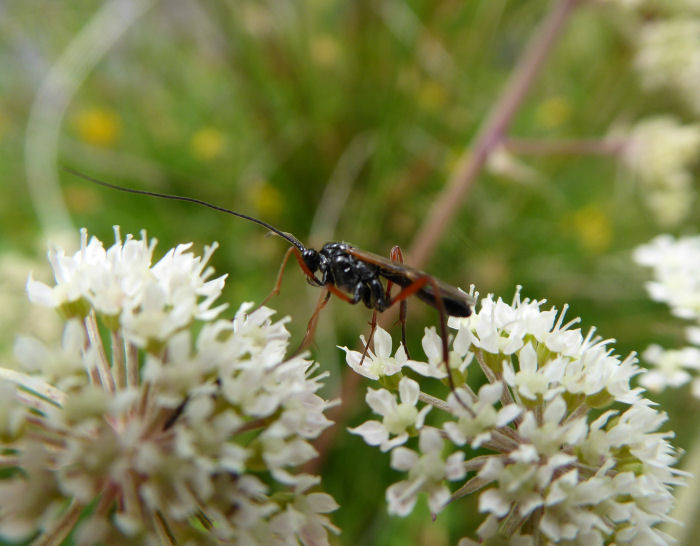
Our moth morning yet again yielded more new species and this interesting comment from Charlie Fletcher.
'Excellent trapping session at the reserve on Tuesday night. An impressive count of 158 species. 20 site records and one species (Caryocolum tricolorella) new for VC65 – it’s a pretty scarce moth whose larvae feed on greater stitchwort. Dark Umber was unexpected. It’s a buckthorn feeder and the nearest known populations are in the Ripon area. I realised there is buckthorn planted at the site but it must have come from somewhere not too far away so I wonder where the nearest wild buckthorn is.'
Unfortunately no photo is available at this time for this moth but we may catch one again, fingers crossed. Forty seven Antler moths were caught.
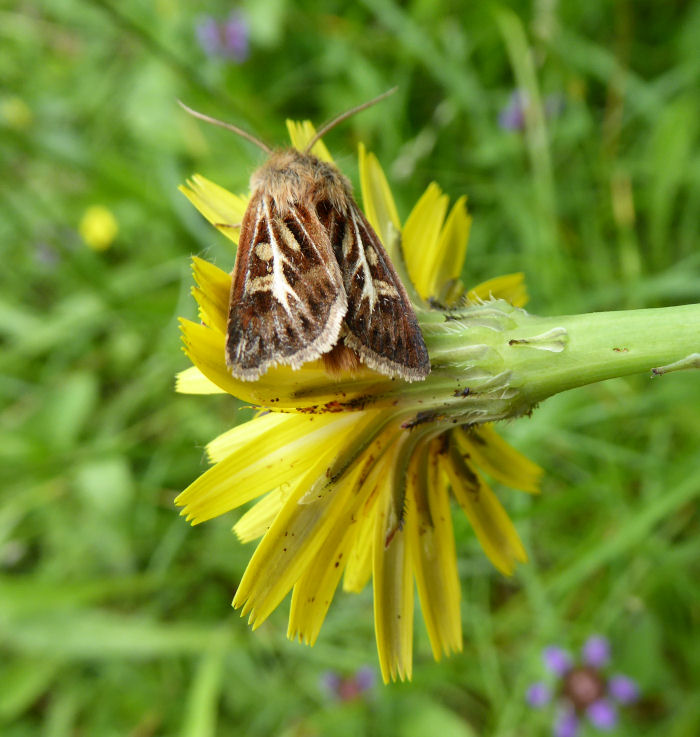
A combination of habitat management, being more observant and possibly climate change means that we can still add new species to our species list.
A Mixture
Saturday, August 6th 2016
August is a month when some plants reach the height of their flowering season, whilst others are already preparing for autumn. Raspberries are ripening and are enjoyed by the Blackcaps.

Blackberries are still in flower, providing food for a myriad of insects.

Rowan berries have turned red and will soon be host to Blackbirds.
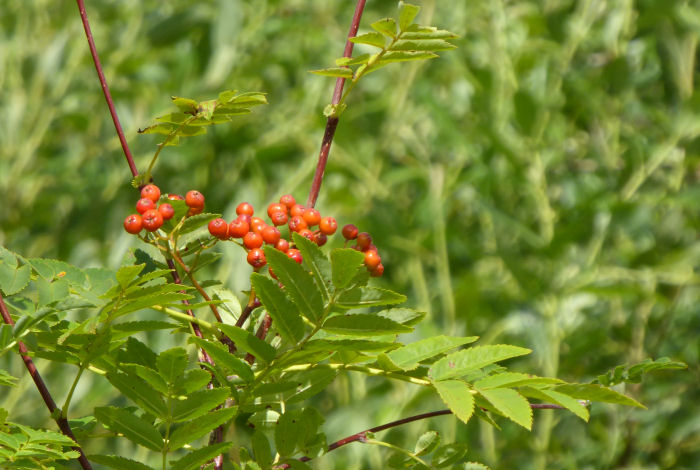
Pepper Saxifrage has at last flowered. We were beginning to think that it had disappeared when suddenly there is was! On one plant there are flowers and seeds.
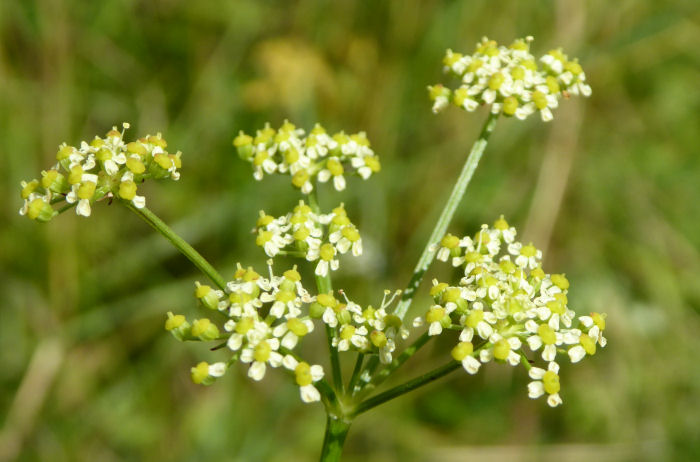
The seeds are colourful, in comparison to the flower.

August also sees us getting excited about spiders as mornings of dew highlight spider's webs.

And leave water droplets on Phragmities leaves.

Fruit Salad
Friday, August 5th 2016
Over the last few days we have been investigating what else our Water voles like to eat. Websites state that Water voles have been recorded eating 227 different species of plant. So we decided to offer them a number of tasty treats. Options have been strawberries, blackberries, grapes and carrots. However, the photos below show the evidence that they are really not interested in what we had hoped would be a tasty alternative, and have left the other options to rot, instead continuing to munch their way quite happily through their less interesting apples!
All over the reserve signs are starting to appear that summer is racing on. These Hazelnuts are almost fully formed, although are still a little way from turning brown yet.
Other jobs today included catching up on a lot of not very interesting paperwork, ordering more stock to sell in the field centre, mowing the garden, fixing the boardwalk and checking the net rides. Roger took the canoe out on the lake, as we needed to run a line across the water.
Colin very helpfully came in to fill all the bird feeders ready for bird ringing on Saturday. This is no mean feat and takes a good couple of hours!
A Mix of Jobs
Thursday, August 4th 2016
Today was another busy day, made all the easier because we had volunteers working alongside us. Again this is a prime example of how important the volunteers are to the running of FGC.
To start the day the Reserve Managers split up and had a work party helping with clearing brushwood, and assisting the Tree Surgeons – Sean and Lee.
Keith took a well earned break watching for the Water Vole.

Stacey, Jacky and Elizabeth were running an educational visit for Richmond Day Service, where mini-beast hunting at the outdoor classroom was followed by crafts in the activity room.
The afternoon was again hot and sticky as we finished clearing the brushwood and made piles for processing at a later date; we were also pulling birch and willow along the Scrapes.
Whilst piling up the brushwood I noticed Cinnibar Moth caterpillars on the Ragwort.
Ragwort is poisonous to most mammals, and over time can damage the liver, however these caterpillars use the poison as a deterrent to birds, and their yellow and black stripes also give that warning of ‘I am not good to eat‘!
Another visitor to the Ragwort was this Small Skipper.
Mike and Tony completed the water sampling, which involves testing for nitrates and phosphates in a number of the water sources around the reserve, all results showed a mere trace. They concluded with repairing a step on the moorland, and tree popping.

Peter and I finally got to pull out three redundant posts from the head of the lake, which involved wading in fairly dense mud up to my waist - which reminds me I must fix the hole in the waders!
Thank you to all that helped today.
Minibeasts
Wednesday, August 3rd 2016
Today was busy at Foxglove. At 9pm last night, a number of moth traps were set up by our local Moth expert Charlie Fletcher, spread throughout the reserve. Despite the drizzle overnight, he assured us that it was perfect for moth trapping as is was such a mild night. He obviously knew what he was talking about because this morning we arrived early to work to find the traps laden with moths and already carefully stacked on the front porch of the field centre ready to be identified.
It was a great haul with over 170 species caught. A couple of the nicer ones are shown below. This is Lemptes Gold Spot.
And this is Buff Arches
Today was also Minibeast Safari Morning- one of our Children’s School Holiday activity sessions. The moths tied in nicely with this and the children were able to see how the traps worked and get a good look at the different moths. Afterwards, they were able to release them.
As we had such good numbers present at the event we had to split the group into two. Roger and Karin took the children hunting under logs and up in the trees, while Stacey and Elizabeth headed down to Risedale Beck to see what we could find lurking there.
The weather has been very variable today, with very heavy downpours interspersed with patches of bright blue sky and sunshine. It has been tricky knowing what to put on each time you step out of the door! We would like to thank Charlie and his colleagues for identifying moths for us today. His expertise enables us to do in a morning what would probably take the rest of us several days!
A Damp Work Day
Tuesday, August 2nd 2016
It was a hot and sticky damp drizzly day, but the volunteers, as always, worked like troopers.
We have a major project coming up and the ground work for that needed to be completed. We had some cutting back to be done and a team of us cleared the area in no time.
The board walks were swept and moss and debris were cleared from the path edges, as well as the usual bird feeders filled. As always Ken and Eddie did the rounds with the strimmers, followed by Vince with the leaf blower. It made a massive improvement to the paths.
Whilst clearing up I spotted this Yellow Bellied Fly, Sciara hemerobioides. These dark winged fungus gnats (Sciaridae) are a large family of flies, over 1700 species worldwide, normally these 10 – 11 mm long flies are quite drab in appearance, with black bodies and appendages and dark wings, however this one bucks the trend and has a yellow belly, hence the common name.
They are commonly found in moist environments, and some the larvae of some species are pests of commercial mushroom farms. The adults can be seen in a variety of damp habitats, such as heathlands and wetlands, where the adults feed on nectar from umbelliferous flowers, such as above. The larvae feed on fungi and rotting vegetation.
As stated last week the field centre honey bees were making Queen cells, however for some reason they have dismantled them and killed any developing grubs…. so for now the swarming is unlikely.
Thank you to all who helped today. Next Monday if any volunteers want to attend our special project and help out please do. I will put further information on the blog nearer the day.
Foxglove Summer Barbeque
Monday, August 1st 2016
Yesterday, Foxglove sprang into life at 4:30am, when the bird ringers arrived for the usual 10.5 hour Constant Effort Site ringing day. It was a successful day with 195 bird processed.
This was only one of a number of things occurring at Foxglove on Sunday. At 1pm a number of people joined Keith for a Dragonfly and Damselfly walk around the reserve. Despite having been a sunny day until this point, the sudden clouds made finding good specimens quite tricky. Other people turned up for their own walks around the reserve. Whilst out during the afternoon, some good Kingfisher photographs were snapped by Glennis.

Elizabeth managed to find this nice Dark Green Fritillary butterfly and some very pretty Purple Loostrife.

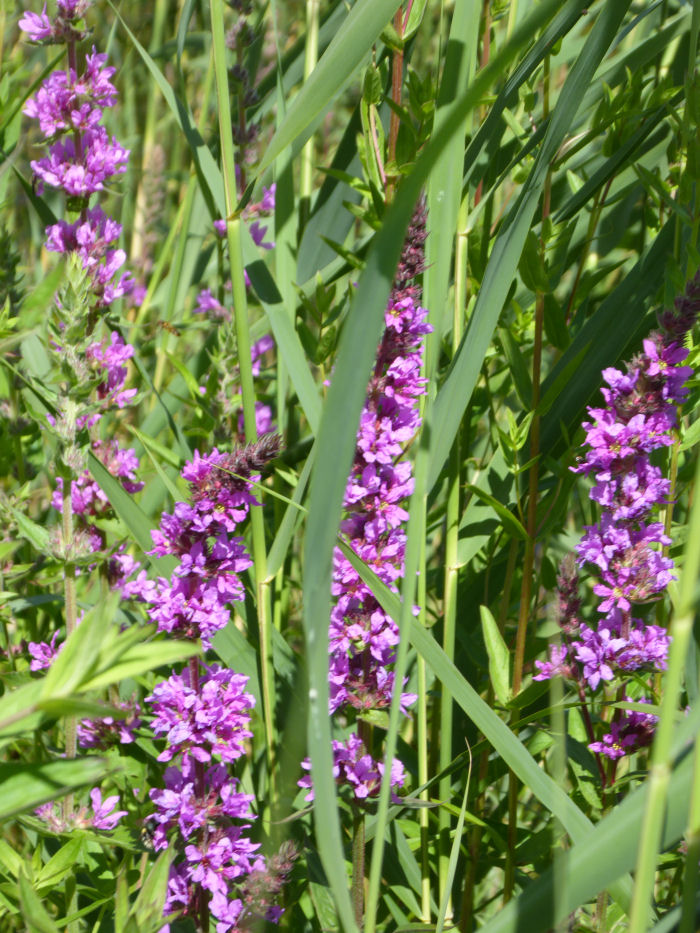
Later in the afternoon the Barbecues were lit, and the food arrived, shortly followed by the Chefs. Finally the Friends and Volunteers of Foxglove arrived to eat it!


The food was splendid with beautifully cooked steaks, Cumberland sausages and marinated chicken to mention just a few, it was far superior to your average burnt beefburger! Not forgetting the vast quantities of tasty cakes and desserts; this should keep our volunteers happy for the rest of this week at least!
Particular thanks go to Keith for leading the guided walk, and for all who contributed to making the day such a success in so many different ways, washing up, clearing up at the end, supplying raffle prizes! A fun day was had by all.


.JPG)


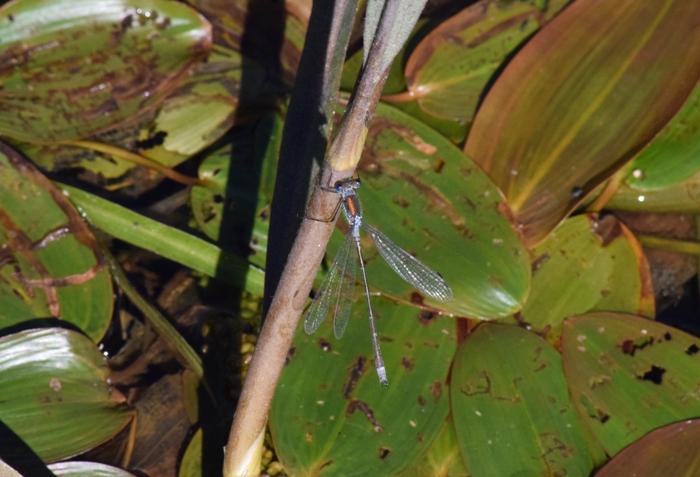
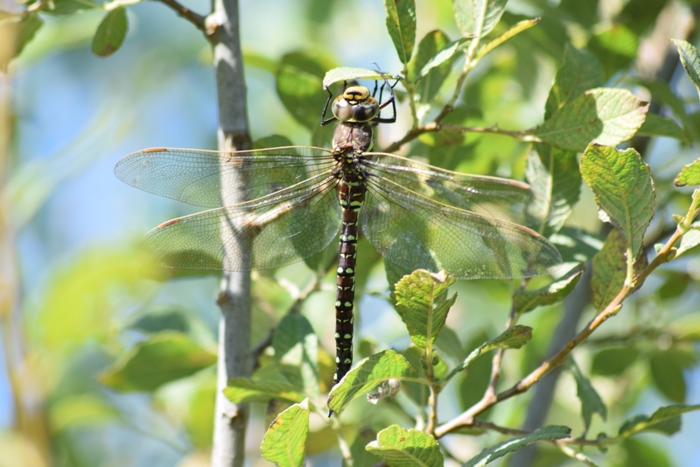



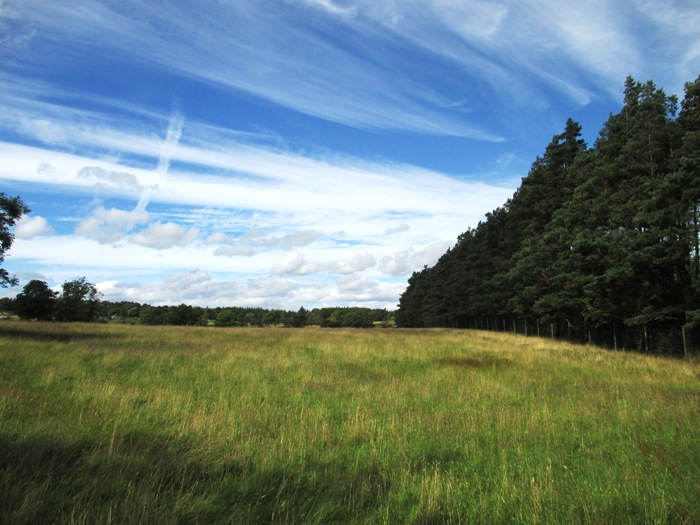




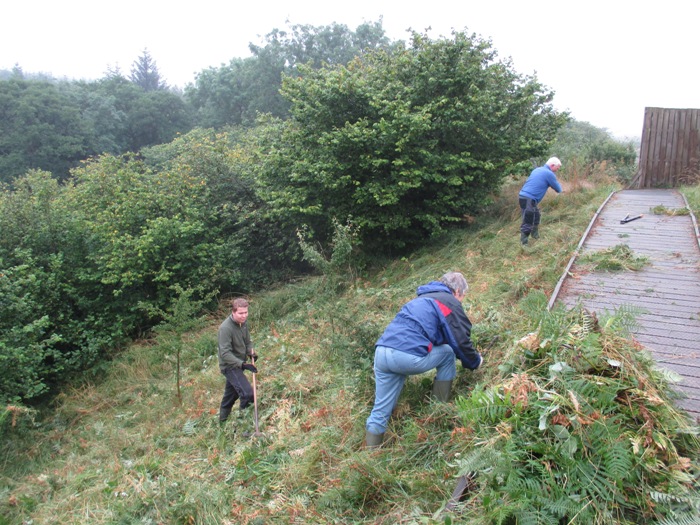
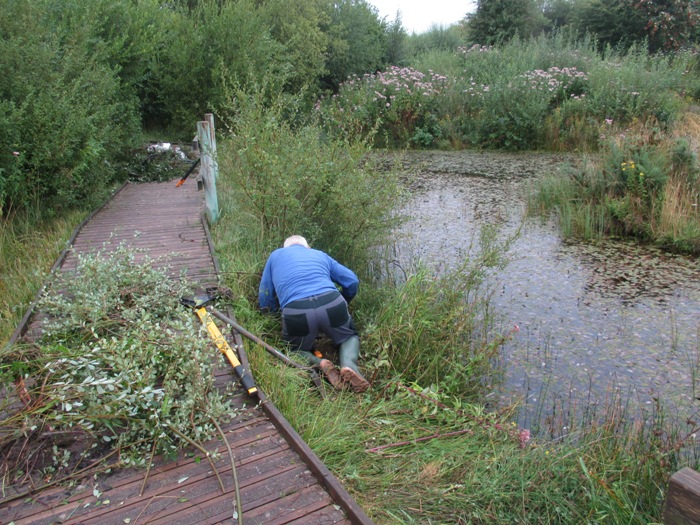


.JPG)
.JPG)





.JPG)
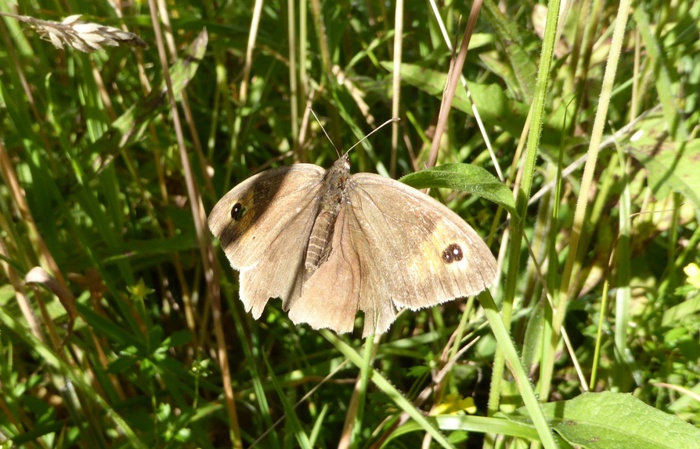
.JPG)
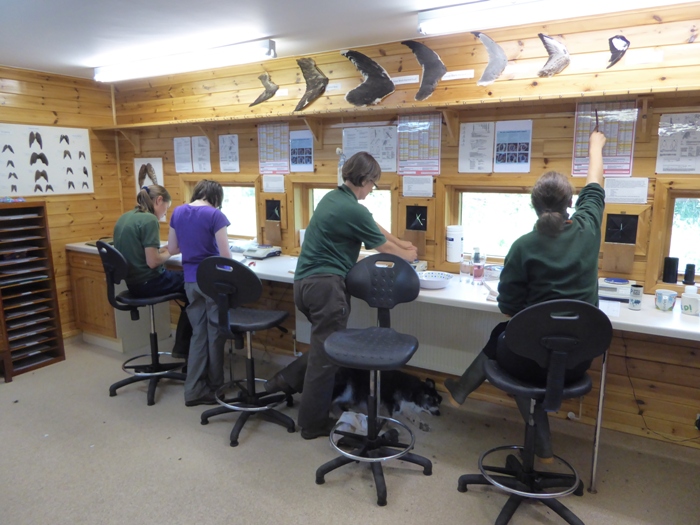






.JPG)
.JPG)
.JPG)
.JPG)
.JPG)
.JPG)

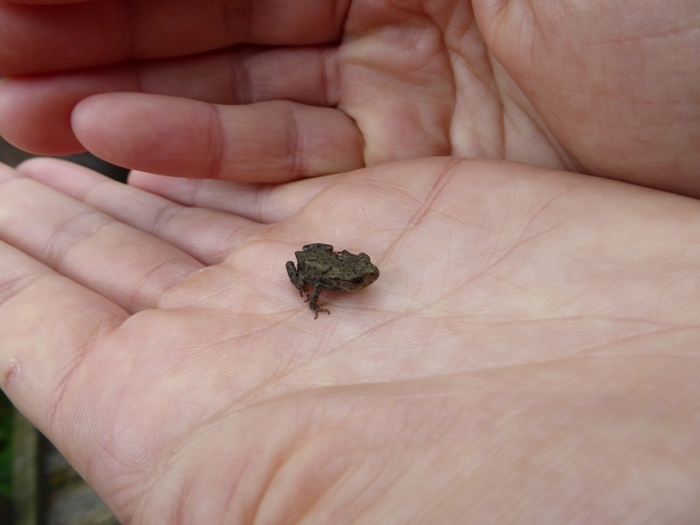



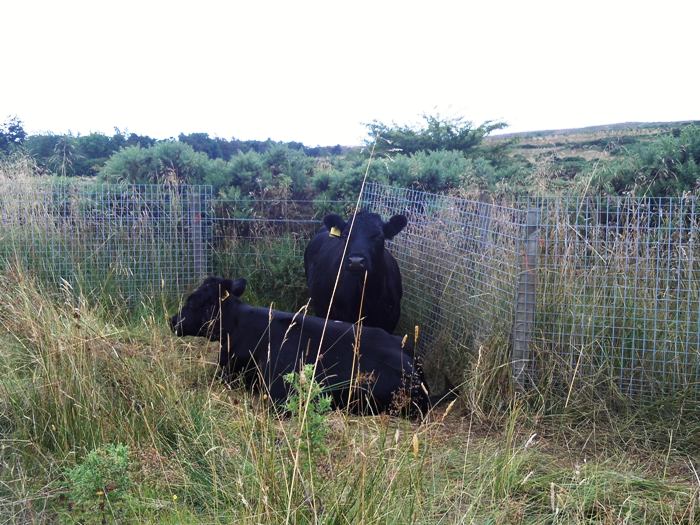
.JPG)


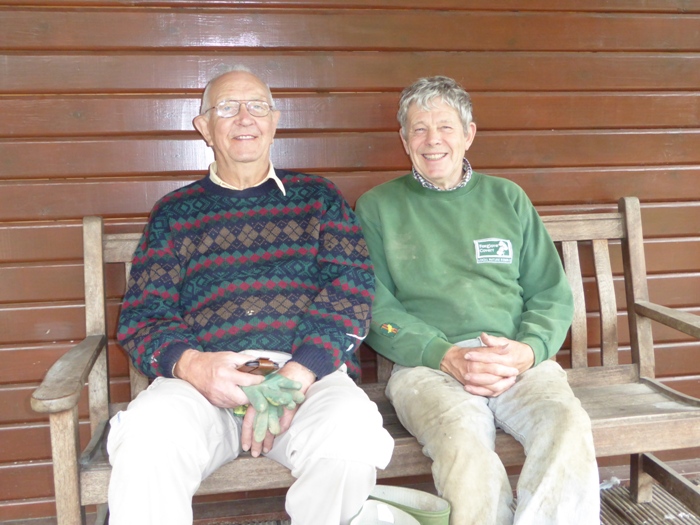






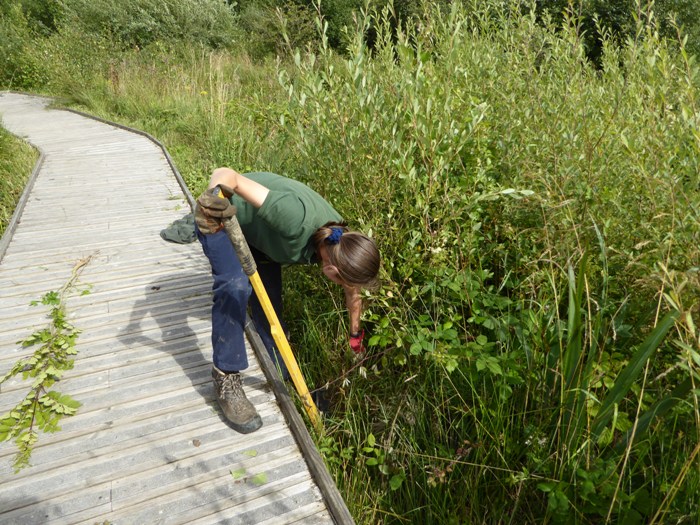



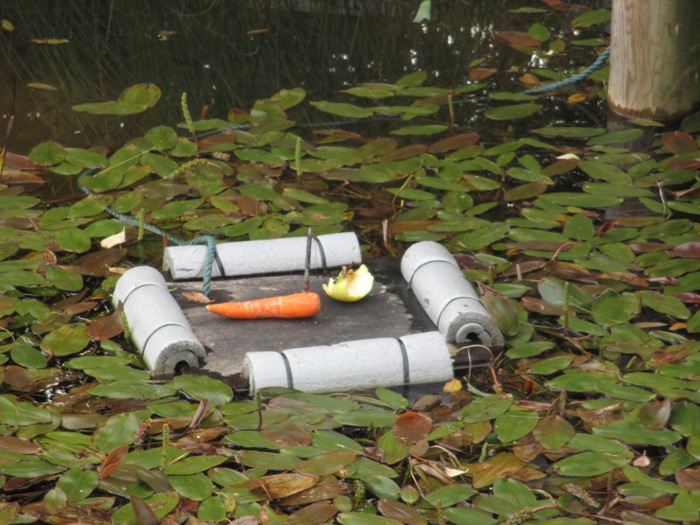






.JPG)
.JPG)
.JPG)


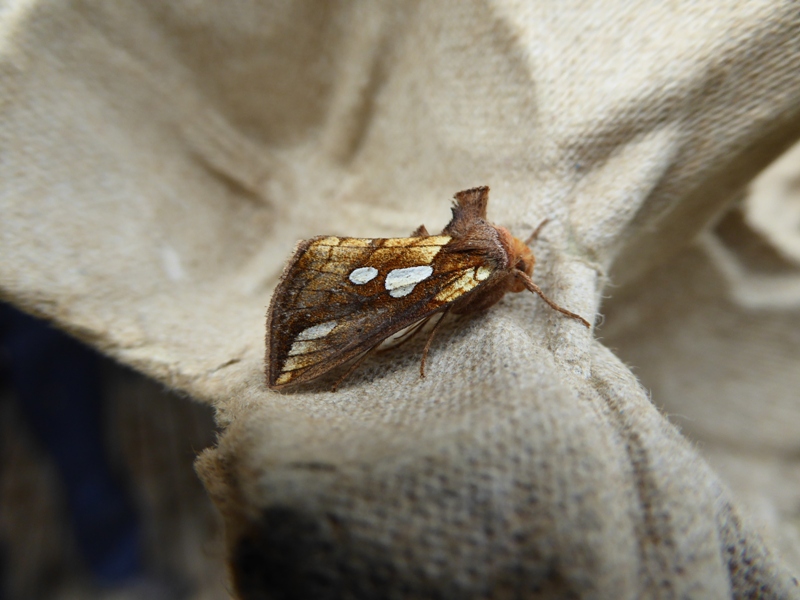



.JPG)

.JPG)

